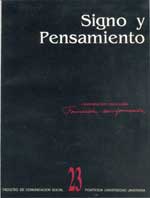Abstract
De acuerdo con Berthoud las características mínimas para asegurar que un mensaje será entendido por la gran mayoría de los destinatarios sirven para que las personas digan: “entiendo lo que me dices” lo cual no significa: “Me interesa me gusta bastante: me llama la atención, nunca lo había pensado: quiero ver mas” para llegar a esto la imagen tiene que ser bella, original, llamativa, emocionante, fantasiosa o humorística, además de ser comprensible. E introducir esos elementos implica el uso de códigos visuales cuyo manejo exige ser probado con los destinatarios antes de utilizar imágenes creadas con esos propósitos. No obstante, para la comunicación educativa, son las personas quienes le dan el sentido a los mensajes, y no al contrario. Por tanto, se preocupa por procedimientos se validación que asuman a los destinatarios como interlocutores fundamentales en la construcción de los mensajes: no como instrumentos de prueba. Para finalizar podemos concluir que todas las imágenes existentes son fenómenos ópticos, desde el punto de vista físico, Sin embargo, las imágenes son también formas de representación de ideas, sentimientos, valores, objetos y seres reales o imaginarios, Por lo tanto, al hecho físico de la percepción agregan la necesidad de leer, de interpretar las representaciones.This journal is registered under a Creative Commons Attribution 4.0 International Public License. Thus, this work may be reproduced, distributed, and publicly shared in digital format, as long as the names of the authors and Pontificia Universidad Javeriana are acknowledged. Others are allowed to quote, adapt, transform, auto-archive, republish, and create based on this material, for any purpose (even commercial ones), provided the authorship is duly acknowledged, a link to the original work is provided, and it is specified if changes have been made. Pontificia Universidad Javeriana does not hold the rights of published works and the authors are solely responsible for the contents of their works; they keep the moral, intellectual, privacy, and publicity rights.
Approving the intervention of the work (review, copy-editing, translation, layout) and the following outreach, are granted through an use license and not through an assignment of rights. This means the journal and Pontificia Universidad Javeriana cannot be held responsible for any ethical malpractice by the authors. As a consequence of the protection granted by the use license, the journal is not required to publish recantations or modify information already published, unless the errata stems from the editorial management process. Publishing contents in this journal does not generate royalties for contributors.


